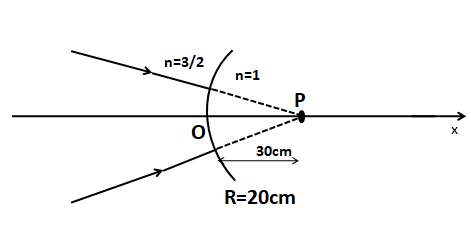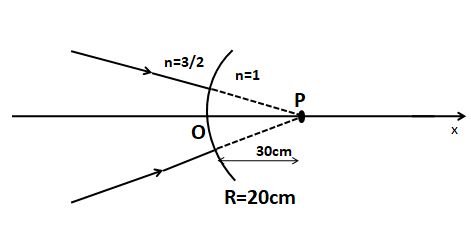
The image for the converging beam after refraction through the curved surface(in the given figure) is formed at.

(a) $x = 40cm$
(b) $x = \dfrac{{40}}{3}cm$
(c) $x = - \dfrac{{40}}{3}cm$
(d) $x = \dfrac{{180}}{7}cm$

Answer
503.1k+ views
Hint: Use the equation for the refraction of light on a convex surface. The equation consists of the refractive indexes of the mediums. Put the values of given refractive indexes and the distance of the object from the surface. By this calculation, the image distance from the surface can be found.
Formula used: For the two mediums of refractive indexes of ${\mu _1}$ and ${\mu _2}$, if the light beam falls on a convex surface from a distance $u$ and makes an image at distance $v$ ,
the equation for the refraction of light on a convex surface will be,
$\dfrac{{{\mu _2}}}{v} - \dfrac{{{\mu _1}}}{u} = \dfrac{{{\mu _2} - {\mu _1}}}{R}$ , $R$ is the radius of curvature.
Complete step-by-step solution:
When an object is placed at a distance $u$ from a convex surface, the light refracts on this curve and thus an image of this object is made at a certain distance from the surface. Let, the image distance from the convex surface is $v$.

Let, the refractive indexes of the two mediums from which to which the light goes, are ${\mu _1}$ and ${\mu _2}$.
The equation for the refraction of light on a convex surface will be,
$\dfrac{{{\mu _2}}}{v} - \dfrac{{{\mu _1}}}{u} = \dfrac{{{\mu _2} - {\mu _1}}}{R}$
Given that, ${\mu _2} = 1$[since it is given n=1]
${\mu _1} = \dfrac{3}{2}$[since it is given n=3/2]
$u = 30$
$R = 20$
Now, from $\dfrac{{{\mu _2}}}{v} - \dfrac{{{\mu _1}}}{u} = \dfrac{{{\mu _2} - {\mu _1}}}{R}$
By putting the values given, we get from the above equation
$ \Rightarrow \dfrac{1}{v} - \dfrac{{\dfrac{3}{2}}}{{30}} = \dfrac{{1 - \dfrac{3}{2}}}{{20}}$
$ \Rightarrow \dfrac{1}{v} - \dfrac{3}{{2 \times 30}} = - \dfrac{1}{{40}}$
$ \Rightarrow \dfrac{1}{v} = \dfrac{1}{{20}} - \dfrac{1}{{40}}$
$ \Rightarrow \dfrac{1}{v} = \dfrac{1}{{40}}$
$ \Rightarrow v = 40$
So the distance of the image here $v = x$
And the calculation we get, $ \Rightarrow v = 40$
Option (a) is the correct answer.
Note: The beam of convergent light rays is when the rays return from completely different directions that finally meet at a selected purpose, then that collection of the rays is known as convergent rays or convergent beams of light. This happens in convex surface incidence.
Divergent is the opposite of merging light. This happens for concave surface incidence.
Formula used: For the two mediums of refractive indexes of ${\mu _1}$ and ${\mu _2}$, if the light beam falls on a convex surface from a distance $u$ and makes an image at distance $v$ ,
the equation for the refraction of light on a convex surface will be,
$\dfrac{{{\mu _2}}}{v} - \dfrac{{{\mu _1}}}{u} = \dfrac{{{\mu _2} - {\mu _1}}}{R}$ , $R$ is the radius of curvature.
Complete step-by-step solution:
When an object is placed at a distance $u$ from a convex surface, the light refracts on this curve and thus an image of this object is made at a certain distance from the surface. Let, the image distance from the convex surface is $v$.

Let, the refractive indexes of the two mediums from which to which the light goes, are ${\mu _1}$ and ${\mu _2}$.
The equation for the refraction of light on a convex surface will be,
$\dfrac{{{\mu _2}}}{v} - \dfrac{{{\mu _1}}}{u} = \dfrac{{{\mu _2} - {\mu _1}}}{R}$
Given that, ${\mu _2} = 1$[since it is given n=1]
${\mu _1} = \dfrac{3}{2}$[since it is given n=3/2]
$u = 30$
$R = 20$
Now, from $\dfrac{{{\mu _2}}}{v} - \dfrac{{{\mu _1}}}{u} = \dfrac{{{\mu _2} - {\mu _1}}}{R}$
By putting the values given, we get from the above equation
$ \Rightarrow \dfrac{1}{v} - \dfrac{{\dfrac{3}{2}}}{{30}} = \dfrac{{1 - \dfrac{3}{2}}}{{20}}$
$ \Rightarrow \dfrac{1}{v} - \dfrac{3}{{2 \times 30}} = - \dfrac{1}{{40}}$
$ \Rightarrow \dfrac{1}{v} = \dfrac{1}{{20}} - \dfrac{1}{{40}}$
$ \Rightarrow \dfrac{1}{v} = \dfrac{1}{{40}}$
$ \Rightarrow v = 40$
So the distance of the image here $v = x$
And the calculation we get, $ \Rightarrow v = 40$
Option (a) is the correct answer.
Note: The beam of convergent light rays is when the rays return from completely different directions that finally meet at a selected purpose, then that collection of the rays is known as convergent rays or convergent beams of light. This happens in convex surface incidence.
Divergent is the opposite of merging light. This happens for concave surface incidence.
Recently Updated Pages
A man running at a speed 5 ms is viewed in the side class 12 physics CBSE

The number of solutions in x in 02pi for which sqrt class 12 maths CBSE

State and explain Hardy Weinbergs Principle class 12 biology CBSE

Write any two methods of preparation of phenol Give class 12 chemistry CBSE

Which of the following statements is wrong a Amnion class 12 biology CBSE

Differentiate between action potential and resting class 12 biology CBSE

Trending doubts
What are the major means of transport Explain each class 12 social science CBSE

Which are the Top 10 Largest Countries of the World?

Draw a labelled sketch of the human eye class 12 physics CBSE

Explain sex determination in humans with line diag class 12 biology CBSE

Explain sex determination in humans with the help of class 12 biology CBSE

Differentiate between homogeneous and heterogeneous class 12 chemistry CBSE




